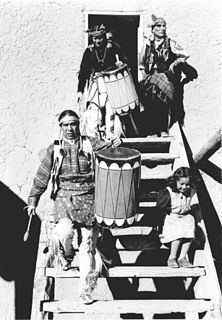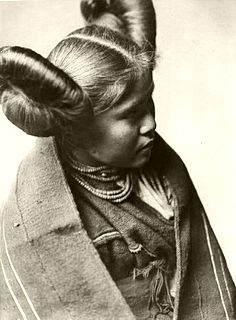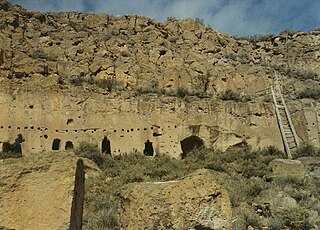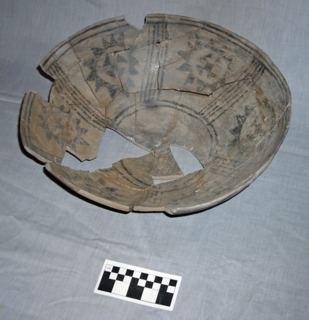The Puebloans or Pueblo peoples, are Native Americans in the Southwestern United States who share common agricultural, material and religious practices. When Spaniards entered the area beginning in the 16th century, they came across complex, multi-story villages built of adobe, stone and other local materials, which they called pueblos, or towns, a term that later came to refer also to the peoples who live in these villages.

Santa Clara Pueblo is a census-designated place (CDP) in Rio Arriba County, New Mexico, United States and a federally recognized tribe of Native American Pueblo people. Santa Clara Pueblo was established about 1550.

San Ildefonso Pueblo is a census-designated place (CDP) in Santa Fe County, New Mexico, United States, and a federally recognized tribe, established c. 1300 C.E. The Pueblo is self-governing and is part of the Santa Fe, New Mexico Metropolitan Statistical Area. The population was 524 as of the 2010 census, reported by the State of New Mexico as 1,524 in 2012, and there were 628 enrolled tribal members reported as of 2012 according to the Department of the Interior. San Ildefonso Pueblo is a member of the Eight Northern Pueblos, and the pueblo people are from the Tewa ethnic group of Native Americans, who speak the Tewa language.
The Pueblo Revolt of 1680—also known as Popé's Rebellion—was an uprising of most of the indigenous Pueblo people against the Spanish colonizers in the province of Santa Fe de Nuevo México, present day New Mexico. The Pueblo Revolt killed 400 Spanish and drove the remaining 2,000 settlers out of the province.

Tanoan, also Kiowa–Tanoan or Tanoan–Kiowa, is a family of languages spoken by indigenous peoples in present-day New Mexico, Kansas, Oklahoma, and Texas.
Tewa is a Tanoan language spoken by Pueblo people, mostly in the Rio Grande valley in New Mexico north of Santa Fe, and in Arizona. It is also known as Tano, or (archaic) Tée-wah.

The Tewa are a linguistic group of Pueblo Native Americans who speak the Tewa language and share the Pueblo culture. Their homelands are on or near the Rio Grande in New Mexico north of Santa Fe. They comprise the following communities:

The Puye Cliff Dwellings are the ruins of an abandoned pueblo, located in Santa Clara Canyon on Santa Clara Pueblo land near Española, New Mexico. The site was declared a National Historic Landmark in 1966.

The Jemez Mountains ([ˡhɛmɛz]) are a volcanic group of mountains in Rio Arriba, Sandoval, and Los Alamos counties, New Mexico, United States.
Although the DeSoto expedition fought numerous battles earlier, the Tiguex War was the first named war between Europeans and Native Americans in what is now the United States. It was fought in the winter of 1540-41 by the expedition of Francisco Vázquez de Coronado against the twelve or thirteen pueblos of Tiwa Indians as well as other Puebloan tribes along both sides of the Rio Grande, north and south of present-day Bernalillo, New Mexico, in what was called the Tiguex Province. The only book-length treatment of the Tiguex War is in the historical novel, Winter of the Metal People.
The Hopi-Tewa are a Tewa Pueblo group that resides on the eastern part of the Hopi Reservation on or near First Mesa in northeastern Arizona.

Nambé Oweenge Pueblo is a census-designated place (CDP) in Santa Fe County, New Mexico, United States and a federally recognized tribe of Native American Pueblo people. The Pueblo of Nambé has existed since the 14th century and is a member of the Eight Northern Pueblos. It was a primary cultural, economic, and religious center at the time of the arrival of Spanish colonists in the very early 17th century. The community of Nambe is separate from the pueblo. Nambé was one of the Pueblos that organized and participated in the Pueblo Revolt of 1680, trying to expel the Spanish from the area.

Ohkay Owingeh is a census-designated place (CDP) in Rio Arriba County, New Mexico, United States and a federally recognized tribe of Native American Pueblo people. The 2010 census found that 1,143 people lived in the CDP, while 1,522 people in the U.S. reported being exclusively Ohkay Owingeh and 1,770 people reported being Ohkay Owingeh exclusively or in combination with another group.

The Tsama Pueblo is a Tewa Pueblo ancestral site in an address-restricted area of Abiquiú, New Mexico. It was occupied from around 1250 until around 1500 and contained 1100 rooms. The site and others in the area were explored by Florence Hawley Ellis in the 1960s and 1970s. In 1983, it was listed on the National Register of Historic Places listings in Rio Arriba County, New Mexico. Tsama is located 3 miles (4.8 km) from the Poshuouinge site. The Sapawe site is closely related. In December 2008, The Archaeological Conservancy extended the Tsama Archaeological Preserve by 11.6523 acres, mostly cobble mulch garden plots which were likely once constructed by the residents of Tsama Pueblo.
Howiri is a Tewa Pueblo ancestral site in Taos County, New Mexico, United States. Its ten circular kivas are located on the east bank of Rio Ojo Caliente, near Homayo. It was occupied from around 1400 until around 1525. In 1983, it was listed on the National Register of Historic Places listings in Taos County, New Mexico.
Homayo is one of the principal Tewa Pueblo ancestral sites in New Mexico, US. Located on the west bank of the Rio Ojo Caliente, there are seven kivas. It is a large, compactly built pueblo ruin situated on a promontory on the west side of the river about a 1.5 miles (2.4 km) above Posege. The walls are of adobe about 1 foot (0.30 m). The kivas vary from 30–50 feet (9.1–15.2 m) in diameter and are all of the circular form. The village was well situated for defense, as it can be approached readily from the west side only. There is one main plaza or court which appears completely closed. Attached to this on the east are two sections which partially enclose another and smaller court. Three detached sections stand at a little distance from the main quadrangle.
Posege is one of the principal Tewa Pueblo ancestral sites in New Mexico, US. Located on the banks of the Rio Ojo Caliente at the site of Ojo Caliente, there were 13 kivas, and a population of approximately 2,000.
Teeuinge is one of the principal Tewa Pueblo ancestral sites in New Mexico, US. It is situated in the southerly angle formed by the juncture of Rio Oso and Rio Chama. The site measures approximately 525 feet (160 m) by 210 feet (64 m). It is a large ruin situated on the rim of the mesa overlooking the valley, just below the confluence of the two rivers. It is about .25 miles (0.40 km) south of the river, and the bluff on which it stands is about 200 feet (61 m). The pueblo was constructed of adobe with some use of lava blocks in the foundation walls, and is now reduced to low mounds. It was built in two large adjoining quadrangles, or as one long rectangle divided by cross walls into two courts. The walls have a perimeter of 1,470 feet (450 m). Within and contiguous to the pueblo are ten circular, subterranean kivas. A few yards to the east is a ruined shrine in circular form, 8 feet (2.4 m) in diameter, built of lava blocks set on edge.

Riverside is a former village, now a suburb of Española, New Mexico, in Rio Arriba County, New Mexico, in the southwestern United States. It is located in north-central New Mexico, on the left bank of the Rio Grande across the river from Española proper. It is on NM Route 68 just north of US Route 285 and just south of the former village of Santa Niño. To the southeast is the former village of San Pedro.











